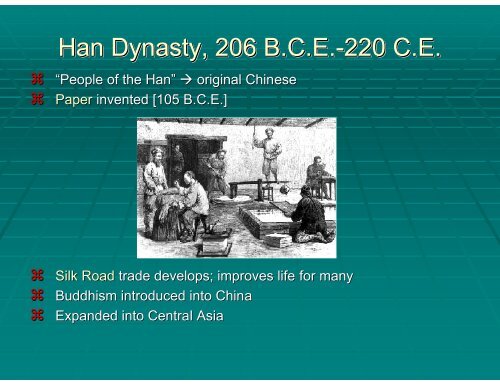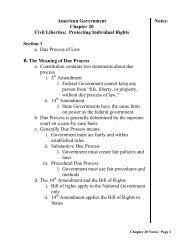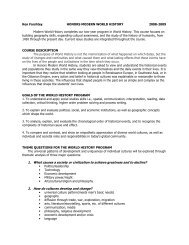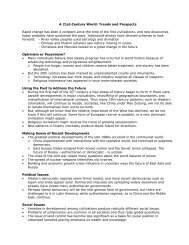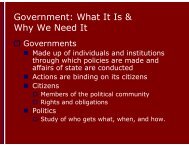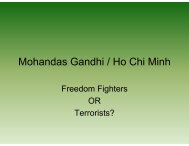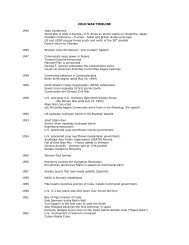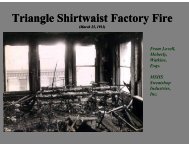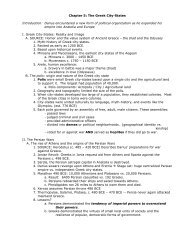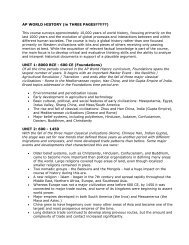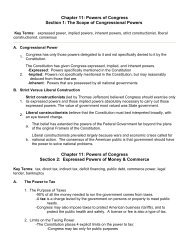Han Dynasty, 206 BCE-220 CE Han Dynasty, 206 BCE-220 CE
Han Dynasty, 206 BCE-220 CE Han Dynasty, 206 BCE-220 CE
Han Dynasty, 206 BCE-220 CE Han Dynasty, 206 BCE-220 CE
- No tags were found...
Create successful ePaper yourself
Turn your PDF publications into a flip-book with our unique Google optimized e-Paper software.
<strong>Han</strong> <strong>Dynasty</strong>, <strong>206</strong> B.C.E.-<strong>220</strong> C.E. “People of the <strong>Han</strong>” original Chinese Paper invented [105 B.C.E.] Silk Road trade develops; improves life for many Buddhism introduced into China Expanded into Central Asia
The Long Reign of the <strong>Han</strong>(<strong>206</strong> b.c.e.–<strong>220</strong>c.e.).)• Liu Bang, a peasantwho defeated all othercontestants for controlof China, establishedthe <strong>Han</strong> dynasty• The <strong>Han</strong> establisheda political system thatdrew on bothConfucian philosophyand Legalisttechniques
<strong>Han</strong> Organizing Principles• Heaven, earth, man form eternal trinity• Economic welfare is basis of popularmorality• Government must provide peace &prosperity, & education• Moral education through rites, music &literature
Concept of Imperial Power• Emperor is a moral agent• Representative of hierarchical order ofmankind• A reflection of the order of the universe• Responsible for keeping mankind in harmony• Does this through moral suasion• Sets a moral example• Goodness & virtue given embodiment in rites& music
Central Government• The central government was run by twochief officials and included a number offunctionally specialized ministers• Local officials collected taxes, draftedmen for corvée labor and militaryservice, and settled local disputes
• Most people had no contact with thecentral government.• Local officials were supplied by a class ofmoderately wealthy, educated locallandowners whom historians refer to asthe “gentry. gentry.”• The gentry adopted Confucianism as theirideology and pursued careers in the civilservice
The Government• Bureaucracy• Highly organized & centralized government• Civil Service Exam• Scores determined who received positions inthe government• Exams based on Confucian philosophy• No favoritism; had to prove they werequalified
Civil Service Examination• During the <strong>Han</strong> dynasty, a civil serviceexamination based on Confucianism wasestablished.• In order to work in the Chinese government, aman had to pass an examination on Chinesehistory and Confucianism.• Only scholars could work in the government.
<strong>Han</strong> BureaucracyEMPERORLOCAL GOVERNMENTSTHREE EX<strong>CE</strong>LLENCIESPrefectureCommanderyChancellor Grandee Secretary Commander-in-chiefDistrictInspecting SecretaryCommandery CommandantSpecialistsChancellor’s OfficeGeneralsCommune10 MinistersArmiesVillage
Chang’anThe <strong>Han</strong> Capital
• Chang’an was an easily defended walledcity with easy access to good arable land.The population in 2 c.e. was 246,000.Other cities and towns imitated the urbanplanning of Chang’an
Living in Chang’ an• The elite of Chang’an lived in elegantmultistoried houses arranged on broad,well-planned boulevards• They dressed in fine silks, wereconnoisseurs of art and literature, andindulged in numerous entertainments• The common people lived in closelypacked houses in largely unplanned,winding alleys
The Emperor in Chang’an• The emperor was supreme in the state and insociety• He was regarded as the Son of Heaven, the linkbetween heaven and the human world• Emperors were the source of law.• But anything that went seriously wrong could beinterpreted to mean that the emperor was guiltyof misrule and that he was losing the Mandate ofHeaven
• Emperors lived in seclusion,surrounded by a royal retinue thatincluded wives, family, servants,courtiers, and officials
<strong>Han</strong> Territorial Expansion• After a period of consolidation, the <strong>Han</strong>went through a period of territorialexpansion under Emperor Wu(r. 140–87b.c.e.).)• During the Western <strong>Han</strong> period (202b.c.e.–8 c.e.) .) the capital was at Chang’anan.• During the Eastern <strong>Han</strong> (23–2222 c.e.) .) thecapital was at Luoyang.
Emperor Wudi, , 141-87 B.C.E. Started public schools. Colonized Manchuria,Korea, & Vietnam. Civil service system• bureaucrats• Confucian scholar-gentry Revival of Chineselandscape painting.
The Economy• The Silk Road trade route thatconnected Xian China to Rome• Chinese exported silk to rest of the world• Sold the Government stored surplus grain,iron, & salt• surplus to raise income instead of raising taxes
Overland Trade• During the <strong>Han</strong> dynasty, merchantsestablished overland trade routes to othercenters of civilization.• The Silk Road went through Central Asiato the Middle East.• The Silk Road was a famous Chinesetrading route.
Trade Routes of the Ancient World
Cultural Diffusion• Cultural diffusion is the exchange ofcultural ideas and/or objects.• The Silk Road encouraged culturaldiffusion.• Chinese ideas and objects wereintroduced to other cultures.
Chinese contactwith India led tothe introductionof Buddhism inChina.
Achievements• Paper• Wheel Barrow• Compass• Seismograph
Achievements• Acupuncture• Inserting needles into certain points in the human body canalleviate pain• Believed to restore health & well being
<strong>Han</strong> ArtifactsImperialSeal<strong>Han</strong> CeramicHouse


